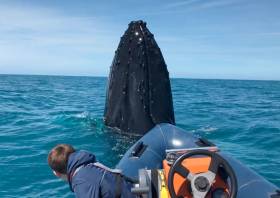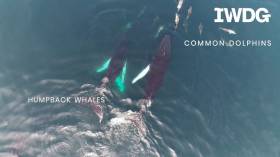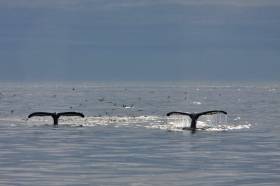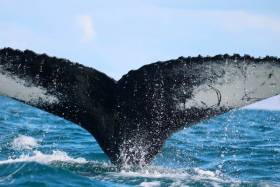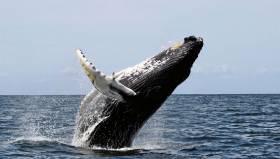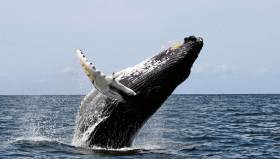Displaying items by tag: humpback whales
Father and son Terry and Tomás Deane went out from the Kerry coast on the longest day of the year with the intention of finding marine wildlife.
But little did they expect they would come face-to-face with a pod of humpback whales — one of which spyhopped off the bow of their RIB.
As RTÉ news reports, the duo spent an hour watching the pod of three humpbacks feeding some 15 miles north-west of Brandon before the cetaceans approached their small boat.
The magical moment when a 14-year-old boy came face to face with a humpback whale off the Co Kerry coast ? pic.twitter.com/g6Yr0MP3zr
— RTÉ News (@rtenews) July 16, 2019
Using a GoPro camera, they were able to film the whales swimming about around and beneath their vessel before the surprising moment when one spyhopped — surfaced vertically to get a better look — just feet away.
“It was unreal,” says Terry. “We were shaking, not with fear, but in awe.”
RTÉ News has more on the story HERE.
Sixteen years after the Irish Whale and Dolphin Group’s (IWDG) first attempt to find the origins of Ireland’s humpback whales, a chance excursion on the latest expedition to Cape Verde has finally revealed the breeding grounds for these threatened marine wildlife visitors.
It was long suspected that the waters around the island chain off West Africa were the most likely breeding area for humpbacks that have been sighted nearly 1,000 times and photographed ever 100 times in Irish waters over the last two decades.
But that wasn’t confirmed until this April during a two-week expedition, when on a trip to a known breeding spot in Santa Monica off Boavista, IWDG chief Simon Berrow photographed two humpbacks that surfaced near his boat.
One of these whales was identified by the group’s international network of experts as an individual sighted by Nick Massett off Kerry four years ago. It was just the match they’d been searching for.
“What a fantastic outcome for the IWDG,” said Massett at the news. “It was born out of the belief that the Cape Verde islands was the breeding ground for the humpbacks we have documented here off Ireland. But it is down to the dogged persistence of the expedition teams that have returned there over the years to prove the theory.
“I am delighted for Simon Berrow that he finally got the definitive proof of this connection, and pleased to have played my part in documenting the animal here off Co Kerry.”
Also celebrating the achievement was IWDG sightings officer Pádraig Whooley, who had been beginning to doubt whether they had been looking in the right place all these years.
“We’ve finally found a really important missing piece of the jigsaw,” said Whooley, “but it’s a very large puzzle, which still has lots of missing pieces.”
The next steps for the IWDG are to determine how to use this information to enhance conservation for the endangered species, perhaps involving a greater level of co-operation between the Irish and Cape Verdean governments.
Meanwhile, the group will follow-up this find with another expedition to Cape Verde this coming September.
Whale watchers have captured spectacular aerial video of a group of humpback whales spotted “socialising” off West Cork.
The Irish Whale and Dolphin Group’s science officer Seán O’Callaghan filmed the remarkable scene last month just days after the first humpback whale sighing of the year was made in the same region, sailing out of Reen Pier.
“We had perfect sea conditions to search for cetaceans (whales, dolphins and porpoises) but our efforts to spot distant large whale blows were hampered by Saharan sand that caused a thick haze at sea,” the IWDG said.
“However, we did connect with up to six humpback whales feeding and socialising in offshore waters which allowed us to collect the first set of aerial images and video that will be used to estimate the length and body condition of these iconic giants.”
The video shows four of the humpback whales interacting with each other while common dolphins swim just ahead and among them.
And it marks the first significant contribution to WhaleTrack Ireland — the IWDG’s new drone-based citizen science project, supported by Ryanair, which aims to find out what these and other marine wildlife giants are doing within and beyond Irish waters.
Irish Whale & Dolphin Group Continues Its ‘Trail Of The Whale’ Library Tour Across The Country
The Irish Whale and Dolphin Group (IWDG) is bringing stories from the Celtic Mist’s historic marine wildlife survey voyage around Iceland to libraries and other venues nationwide.
Already the IWDG has visited 10 venues across eight counties in its ‘On the Trail of the Whale’ tour, which continues tonight (Tuesday 19 February) at 7pm in Killarney Library.
In May last year a crew of marine scientists and enthusiasts set sail on the IWDG’s research yacht for a weeks-long return passage to the edge of the Arctic Circle in search of humpback whales, building “strong links with Iceland and its people” along the way.
Last month, IWDG members began sharing their experiences from the rewarding mission in images, stories and video of the voyage to audiences in libraries and other venues across the island of Ireland — beginning on 14 January at DLR LexIcon and since visiting Galway, Tralee, Monaghan town and Arklow, as well as Bangor and Warrenpoint in Northern Ireland and Dublin’s Poolbeg Yacht Club.
“Through the tour, we want to encourage people to get involved,” IWDG’s chief science officer Dr Simon Berrow told the Irish Examiner. “If even one person at every event we do gets interested [in marine life] and gets motivated, that’s fantastic.”
The Irish Examiner has much more on the story HERE.
New Humpback Whale Spotted Off West Cork
#MarineWildlife - Amid a flurry of activity off the Bear Peninsula in West Cork last week was the discovery of a new humpback whale visitor to Irish waters.
Using images captured by marine mammal observation officer Patrick Lyne near Inchydoney on Saturday 31 March, the Irish Whale and Dolphin Group was able to confirm it was a small humpback not previously recorded — and it is now the 86th edition of the species to the IWDG’s catalogue.
“In recent years this resource has seen impressive growth, as humpback sightings have outstripped the larger fin whales,” says IWDG sightings officer Pádraig Wholley. “Of particular interest is 2015, when in a single year the number of individuals more than doubled from 30 to 66 animals.”
The IWDG appeals to anyone who has the opportunity to observe or photograph humpback whales this year to pay special attention to ether the ventral flukes or dorsal fins, which can help identify what whales they are and where they might be coming from.
In other cetacean news, BBC News profiles Northern Ireland's only ‘whale listener’, Co Down woman Sharon Doake
Using specialised sonic equipment, Dr Doake's job entails searching for signs of whale and dolphin activity during surveys for offshore oil and gas prospects.
This is particularly important as such seismic surveys can at best scare cetaceans away from their usual feeding grounds, and even potentially cause physical damage.
“It’s not bad to use this equipment but it’s just that we need to mitigate any effect it can have,” she says. BBC News has more on the story HERE.
Ireland’s Whale Watching Season Is Expanding Says IWDG
#MarineWildlife - The Irish Whale and Dolphin Group’s Pádraig Whooley says he has “lost count” of the number of minke whales seen off West Cork in recent days, as The Irish Times reports.
Whales of various cetacean species are now arriving in Ireland in larger numbers much earlier in the year than their usual appearance in autumn, according to the IWDG’s sightings co-ordinator.
Minke whale numbers between Union Hall and Galley Head have been “exceptional” since last week, says Whooley — who also notes that a pod of humpbacks familiar to West Kerry coastal residents has been feeding off Cork over the past fortnight, while the whale known as Boomerang has been spotted off Waterford.
Elsewhere, the Air Corps Maritime Squadron recently captured some astonishing images of sharks feeding on a whale carcass some 200km northwest of Donegal.
“It's not often that we get sent such clear images of a dead cetacean being scavenged on by several sharks,” said IWDG standings officer Mick O'Connell, “but it does give an indication of the importance of dead animals in the food chain.”
First Humpback Whale Of New 2017 Season Sighted Off West Cork
#MarineWildlife - The first humpback whale sighting for the new season in Irish waters was made last week off the Beara Peninsula.
The Irish Whale and Dolphin Group’s (IWDG) Patrick Lyne was in prime position to witness the unmistakable tail fluke some 5km offshore from Beara in West Cork on the afternoon of Wednesday 5 April.
While not the first humpback sighted this calendar year — that honour goes to a giant spotted off Wexford in early January — it’s still considered the first of the 2017/18 ‘large whale season’.
The sighting also continues a trend of earlier arrivals for Ireland’s regular humpback visitors over recent years, with 2016’s first recorded only four days later and spotted just 4km away.
Last Wednesday was a bumper day for marine wildlife sightings off Co Kerry, too, where Nick Massett spotted at least a dozen minke whales between Ventry, Slea Head and the Blaskets.
Many of these locations feature in Colin Stafford-Johnson’s new BBC TV series Wild Ireland, as BBC News reports. The two episodes are currently streaming via the BBC iPlayer, where available.
In other cetacean news, researchers believe that whale strandings may in part be caused by exhaustion when cetaceans flee human-made noise in the ocean.
According to the Irish Independent, a study by marine scientists at UC Santa Cruz found that beaked whales startled by low-frequency sonar raise their energy consumption by almost a third, increasing demands on their limited oxygen supply while below the surface.
The news will be fuel to those who suspect human activity at sea plays a major role in increased cetacean stranding rates.
As previously reported on Afloat.ie, 2017 became the worst year on record for whale and dolphin strandings by mid February.
Whale Watchers Claim First Irish Humpback Sighting Of 2017
#MarineWildlife - Whale watchers off the Sunny South East believed they’ve photographed Ireland’s first humpback whale sighting of 2017, as TheJournal.ie reports.
South Coast Charter Angling skipper Martin Colfer was out with photographer Myles Carroll yesterday (Wednesday 4 January) when they caught a glimpse of the tail fin of the 13-metre-long marine mammal as it slinked back under the surface.
In other Irish whale news, The Times says work has begun on removing the famous diplodocus skeleton replica from London’s Natural History Museum to make way for a blue whale found in Wexford more than a century ago.
As previously reported on Afloat.ie, the whale specimen has been in the museum’s collection since it washed up at Wexford Harbour in 1891, and will now take pride of place in the central that Dippy previously called home since 1905.
Meanwhile, the world’s oldest killer whale is presumed dead after researchers lost track of her movements some months ago, according to the Guardian.
Believed to be 105 years old, ‘Granny’ was the matriarch of a small and endangered group of orcas in Puget Sound, north of Seattle in the north-west United States.
“With regret we now consider her deceased,” researcher Ken Balcomb, who has tracked Granny and her fellow orcas over four decades.
The genetically unique population bares comparison with the distinctive orca pod that splits its time between Ireland and Scotland, and which has faced its own challenges in recent years.
Cape Verde Humpback Whales Doc On TG4 This Weekend
#MarineWildlife - Irish-made documentary The Humpback Whales of Cape Verde will be broadcast this Saturday 29 October at 7.15pm on TG4.
Narrated by Liam Ó Maonlaí and shot in Cape Verde, Ireland and Malta, the film follows Dr Simon Berrow of the the Irish Whale and Dolphin Group (IWDG) and an international team of marine scientists on an ambitious adventure to prove humpback whales from both the northern and southern hemispheres use the Cape Verde archipelago as a breeding ground.
“If we could make the connection, our understanding of humpback whale behaviour in the Atlantic would change,” says Dr Berrow. “Such a breeding ground would be unique. But going there in the first place at that time of year and at significant cost was a big if in itself.”
The lecturer at GMIT also believes the film will help highlight the importance of conservation in Irish waters.
“It still comes as a surprise to many that we have whales in Ireland,” he says. “In fact the numbers here are increasing each year and Ireland is becoming internationally important.
“To understand where whales in Ireland are coming from or going to and breeding is essential to protect them. This film is part of a 12-year search for the breeding grounds of humpback whales in Ireland.”
The broadcast on TG4 this weekend coincides with the 25th anniversary of all Irish waters being declared a whale and dolphin sanctuary, the first of its kind in Europe.
“It is an international story with an Irish perspective,” says director Tony Whelan. “It’s a cracking tale. Spending time with these scientists in an extraordinary environment was a privilege. We hope people enjoy it.
“We are really happy it has been taken up by TG4, an important channel for independent filmmakers. Without them stories like this can go unseen.”
The Humpback Whales of Cape Verde was screened around the country earlier this year as part of a library tour, as previously reported on Afloat.ie.
Humpback Whale Documentary Continues Library Tour
#MarineWildlife - The Humpback Whales of Cape Verde will continue its screening tour of libraries throughout Ireland from next month.
As previously reported on Afloat.ie, the documentary that follows marine wildlife expert Dr Simon Berrow's decade-long study of Atlantic humpbacks – a number of which frequent the Cork coast every year – had a special screening in Clonakilty earlier this week.
That comes after previous showings in Killarney on 23 January, and Dun Laoghaire's new Lexicon on 12 January.
The library tour continues in February with stops across the country scheduled up to summer. Future free screenings are as follows:
- 10 February – Kilkee – 6.30pm
- 25 February – Youghal Library – 7.00pm
- 5 March – Maynooth Library – 3.00pm
- 5 April – Carraroe – 6.00pm
- 14 April – Ballyroan Library, Dublin – 7.00pm
- 21 April – Dungarvan Library – 7.00pm
- 10 May – Ballinasloe Library – 7.00pm
- (Dates in Skibbereen in March and Bray in May are TBC)


























